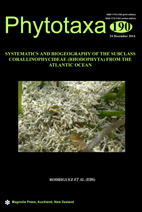Abstract
Crustose Coralline Algae (CCA) are important constituents of tropical coral reef environments throughout the world’s oceans, acting as structural reinforcement and recruitment cues. Despite their importance and their ubiquity, very little is known of the biodiversity of CCA in remote areas of the world’s oceans. On the Saint Peter and Saint Paul Archipelago (SPSPA), located in the central equatorial Atlantic Ocean, CCA occur abundantly in intertidal rock pools and the surrounding subtidal zones. This study represents the first attempt at detailing the CCA species composition for the archipelago along a depth interval between 0 to 70 m. Seven taxa of CCA were identified: Corallinaceae sp., Hydrolithon rupestre, Hydrolithon sp., Lithophyllum johansenii, Lithothamnion muelleri, Mesophyllum engelhartii, and Titanoderma pustulatum pustulatum. A decrease in CCA species richness and change in species composition was seen from shallow to deeper zones that can be explained by a significant reduction in temperature and photon irradiance observed bellow 30 m depth.

